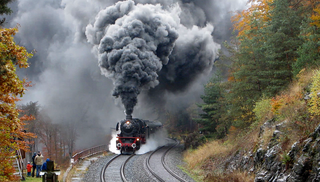
Lamont is a town in Whitman County, Washington, United States. The population was 70 at the 2010 census.

The Burlington Northern Railroad was a United States-based railroad company formed from a merger of four major U.S. railroads. Burlington Northern operated between 1970 and 1996.

The Empire Builder is an Amtrak long-distance passenger train that operates daily between Chicago and – via two sections west of Spokane – Seattle and Portland. Introduced in 1929, it was the flagship passenger train of the Great Northern Railway and its successor, the Burlington Northern, and was retained by Amtrak when it took over intercity rail service in 1971.
The Northwest Railway Museum (NWRM) is a railroad museum in Snoqualmie, King County, Washington. Constructed in 1889 by the Seattle, Lake Shore and Eastern Railway (SLS&E), it was Seattle's response to the Northern Pacific's selecting Tacoma as their terminus. The SLS&E was later absorbed by the Northern Pacific.

Spokane, Portland & Seattle 700 is the oldest and only surviving example of the E-1 class 4-8-4 Northern type steam locomotive. Nearly identical to the A-3 class Northerns built for Northern Pacific Railway, it burns oil instead of coal.
The Spokane, Portland and Seattle Railway (SP&S) locomotive roster was a combination of new and used locomotives. This is not a comprehensive roster.

The Spokane Intermodal Center is an intermodal transport facility located in Spokane, Washington, United States. It serves as a station, re-fueling, and service stop for the Amtrak Empire Builder, as well as the Greyhound, Trailways, and Jefferson Lines station for Spokane. The Empire Builder provides service daily between Chicago, Illinois and Spokane before continuing on to Seattle, Washington or Portland, Oregon.

The Northern Transcon, a route operated by the BNSF Railway, traverses the most northerly route of any railroad in the western United States. This route was originally part of the Chicago, Burlington and Quincy Railroad, Northern Pacific Railway, Great Northern Railway and Spokane, Portland and Seattle Railway systems, merged into the Burlington Northern Railroad system in 1970.

Samtrak was a heritage railroad that operated in Oregon from 1993 to 2001.
The SP&S Class A-1 steam locomotives were a group of 5 identical locomotives. They were used in the rail yards at Portland, Oregon, and Vancouver, Washington, from 1907 to 1952. They were replaced with diesel-electric switch locomotives.
Spokane, Portland and Seattle Railway No. 6 was the only locomotive in Class A-2. Purchased from the Northern Pacific Railway for A. B. Hammond's Astoria and Columbia River Railway, number 6 came to the SP&S secondhand. It was used as a switch locomotive until 1931 when it was sold to the St Helens Terminal and Dock Co. at St. Helens Oregon.
Spokane, Portland and Seattle Railway's Class A-3 was a class of 0-6-0 steam locomotive switchers.
Spokane, Portland and Seattle Railway Class L-1 was a class of 4-4-0 steam locomotives built in 1889 by Schenectady Locomotive Works.
Spokane, Portland and Seattle Railway's Class L-2 was a class of 4-4-0 steam locomotives.
Spokane, Portland and Seattle Railway's Class L-3 was a class of 4-4-0 steam locomotives.
The Spokane, Portland and Seattle Railway (SP&S) class L-4 steam locomotives were originally used by the Astoria and Columbia River Railroad (AC&R). They became SP&S locomotives when the SP&S acquired the A&CR.
On the American Spokane, Portland and Seattle Railway, locomotive number 525 was the only steam locomotive in SP&S class O-2. It was originally built for Northern Pacific by the Schenectady Locomotive Works. Builders number 46878 was built in February 1910.

Spokane Portland and Seattle Railway’s E-1 class was a class of the only three 4-8-4 locomotives built by the Baldwin Locomotive Works in 1938. The E-1 class northerns were very identical to the A-2 through the A-5 class northerns on the Northern Pacific Railroad built by the Baldwin Locomotive Works from 1934-1943. No differences by eyes of people were noticed. The only difference is that the Northern Pacific Railroad 4-8-4s burn coal, and the 4-8-4s on the Spokane, Portland & Seattle Railroad burns oil.

The Oregon Slough Railroad Bridge, also known as the BNSF Railway Bridge 8.8, is a swing-span, through truss bridge in Portland, Oregon, United States. Currently owned and operated by BNSF Railway, it crosses an anabranch of the Columbia River known as North Portland Harbor and historically as the Oregon Slough. The bridge's northern end is on Hayden Island, which, along with Tomahawk Island, forms the north shore of the channel. Completed in 1908, the two-track bridge is one of only two swing bridges surviving in Portland, which once had several bridges of that type, both for road and rail traffic. The only other remaining swing bridge in the Portland area is another rail-only bridge on the same line, BNSF's nearby Bridge 9.6, spanning the Columbia River.









